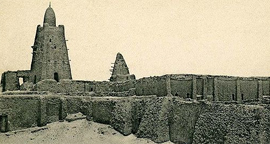Timbuktu is a Medieval West African city established in the 12th century on the southern edge of the Sahara Desert, surrounded by sand dunes, with streets covered in sand. In the West, its name has become synonymous with exotic locales. Timbuktu flourished from trade in salt, gold, ivory and slaves. The city is now within the Republic of Mali, with about 30,000 inhabitants, impoverished and suffering from encroaching desertification.
